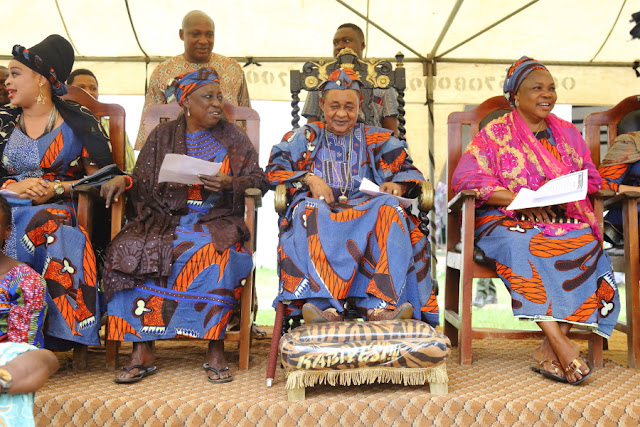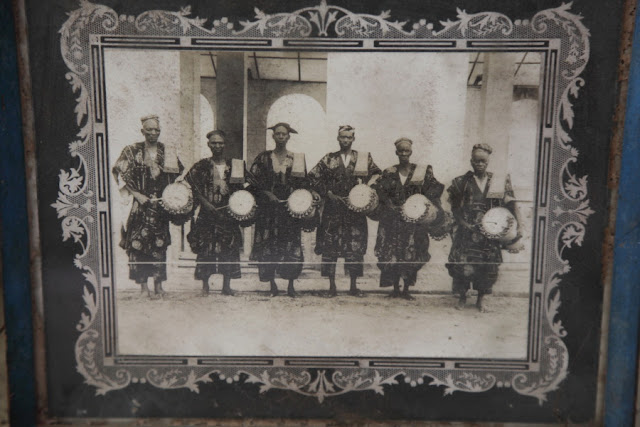 |
| the Alaafin of Oyo and a few wives |
From the origin of the Yorubas to the Alaafin
Olodumare is the name of the Supreme being in Yoruba language.He created the Universe and all divinities (Irunmole), to whom he had delegated His powers on the creation of the earth and the humanity. Obatala was the first divinity to be created and had the responsibility to complete the creation of the earth and to mold the humans.
Obatala in turn created Oduduwa, who the first human being living on the earth and the progenitor of all Yorubas.
Oduduwa had one son called Akanbi, who got several sons, the last of which, called Oranyan is the ancestor of the Alaafin of Oyo.
The Alaafin of Oyo is the traditional ruler of all Yorubas as he is blood-related to Oduduwa.
In contrast the Ooni of Ife is a priest in charge of serving Oduduwa by taking care of the left spiritual property. He is therefore a spiritual ruler of the Yorubas and not blood-related to the Yoruba progenitor.
 |
| the throne of the Alaafin in the audience hall |
Oyo, the center of Yorubaland
Oyo is built on a hill, the palace of the Alaafin is on top of the hill. It is a large walled area which contains several compounds. About 200 people are leaving inside the palace which has many buildings traditionally made of mud. This allows a very good insulation against the heat. The main entrance is a roofed pavilion decorated with various Yoruba symbols (animals, people and a few objects like a sword) carved into the mud and painted in black on the white wall. On the right side are 3 protruding blocks. These are entrances for the newly selected Alaafin who must not enter into the palace from the main gate but through one of the three doors corresponding to his family. One the crowning day, the door is opened by breaking the block closing it and which will be sealed again afterwards.The Alaafin audience hall is a long building made of mud. Inside the walls have been covered with wood to protect the mud and on the outside the wall has been painted in white and decorated with colorful paintings. The roof is protruding and supported by pillars creating a covered walkway all around it. As one enters, through carved wooden doors depicting several symbols of the Yorubas, a long berry-red carpet leads to the throne of the Alaafin elevated on a few steps on which a leopard skin is faces the visitor. On both sides of the carpet, red velvet seats are lined-up. Large wooden eagles are carved on the central ceiling column that stretches through the whole length of the building. Next to the entrance, on the right side as one enters is a life-sized portrait of the Alaafin painted in the 19th century.
 |
| the six drummers of the palace with their talking drums |
We had a look at one of the mud-build servants quarters arranged around a simple inner courtyard. Similarly to the audience building, an outer corridor was used by the guards to sit away from the sun. They were colorfully dressed with cotton robes and the traditional Yoruba hat. All were fairly old. Next to the entrance sat on a wooden armchair, a very-short and very old man. The interior of the building was very minimal furnished. Nails on the wall were used as repository for personal belongings. In the courtyard a large water jar.
Small openings in the wall, about one and half meter above the ground, have been designed for oil-lamps.
 |
| symbolic paintings of Yoruba legends at the entrance of the palace |
The grounds of the palace host several shrines, among them were one for Sango, the divinity of thunder, painted in red and striped with white and beige vertical sinusoidal lines.
As one nears the entrance of the royal compound, drummers with talking-drums make their appearance to greet and announce the visitor, obviously expecting a monetary blessing in return. The drums are less than a meter long and about 30cm in diameter. Goat skin is used to form the top part. Drummers use a wooden stick curved as a question mark. The drum is labelled as a talking drum because it is able to produce different tones. The combination of tones and rhythm is then used to emulate spoken language. The visitors identity is then drummed so that everyone in the palace can be informed about which guest is coming without having to look through the door. The drummers are employed by the Alaafin and have a hereditary charge. Six families are in charge.
A long time ago in 1888, the Queen of England visited the Alaafin and signed a free-trade and friendship agreement with him and his people. So that English citizens would not be taxed in any way for import and export activities. A marble plate captures it on one of the outer walls of a reception halls within the palace
Comments
Post a Comment